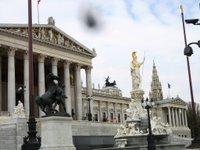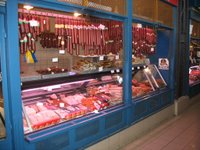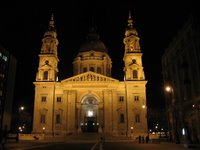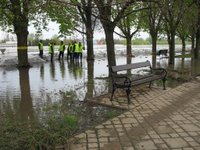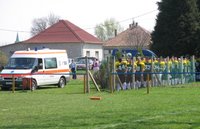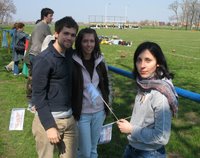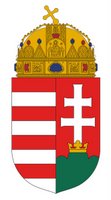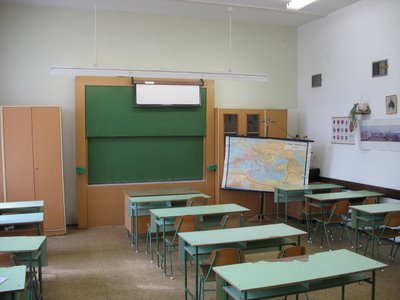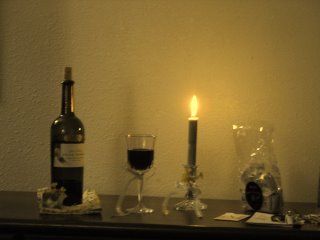Monday was my first day at Varga, and I was pleased to meet two American teachers who are here for the year. Chad is a 23 year old, just out of college, from the Wasington DC area. Mark is in his upper 40's and is from San Francisco. He has taught abroad many times, including stints in Rome and Syria.
I had lunch with Mark at the restaurant across the street from the school (no staff eat at the school cafeteria. Everyone says the food there is terrible and one administrator also told me she thought it was dirty - I wonder why they continue to let the students eat there?).
The restaurant is called Halaszcsarda ("Hal" is the root word for fish, so anytime I see that, I am told to know that it is a seafood restaurant). We both had their signature menu item: Carp Soup. I was given a soup bowl and plate, and the soup was presented in a larger bowl - almost a mini kettle, hanging from a little hook on a stand that was placed at my table. Similar to the way some places serve pizza on a stand at the table. Both of us had out own "kettle" with a ladle in it.
The fish was good - vary flavorful with large chunks of carp and big clumps of roe, or fish eggs. They were good, but will take some getting used to. I had a couple of Cokes (served in little bottles - probably 8 oz. ). We sat and talked for about
5 hours about both of our backgrounds and his experiences teaching overseas and in Hungary. As we sat I had my first beer in Hungary - the German Edelweiss. It's never been one of my favorites as I'm not a weiss drinker, but it was on tap so, when in Rome (or Szolnok)... Total bill for soup, two cokes and one beer: about 1800 ft or $8.25
Monday evening I met up with Chad for dinner at his friend Julia's (different Julia) flat. She is about 25 and a teacher at a nearby elementary school. Chad is here to teach English and tutors at the elementary school in the evening for extra money (about $7-10 per hour). Julia's mother lives nearby and had made a mushroom soup (not creamy) and it was great. She also made some creamy chicken that was served over pasta. It too was good. We sat around the table afterwards picking at a bowl of walnuts and pecans, and drinking pear juice (very yummy). Also there was Emily, a 20-something from Minnesota, also here, like Chad, to teach English, but at the elementary school where Julia works. She has already agreed to stay another year in Szolnok, and has really taken to the Hungarian lifestyle...she is also the best foreign speaker of Hungarian that I have met.
After talking a while, we decided to go to a club and have a beer. There is a place in town called Jazz Klub and inside the atmosphere is exactly what I would have drawn up. They served a beer called Skol which was good. I'm not sure if it's Romanian or Austrian, but it was cold and that was good. By the way,"beer" in Hungarian is "sor" and is pronounced "shoor." I also learned "wine" is pronounced like the English word "boar" but with a heavier, classic Eastern European "o" sound.
The group also decided I should have a shot of the traditional Hungarian liquor:
Unicum (OO-nee-koom). It smells like Jagermeister and is served ice cold, but the aftertaste is very unique - almost herbal. Overall, not bad, but I think I'll stay away from it in the future as it seems like some pretty serious stuff.
Finally I had a glass of
Dreher (Hungarian beer). It was okay and better than I anticipated Hungarian beer to be. It was also cheap: 300 HUF or $1.40 for a 23 oz glass.
While out I learned the Hungarian table cheer: egeszsegere (accent mark over all e's except the last one) - it means "to your health" and is pronounced "EG-uh-shegg-uh-ray." Also, you say it while looking others right in the eyes and you do not clink
beer glasses (other glasses are okay). In 1849, the Hungarians declared independence from the Habsburg rule. However, with the help of the Russians, the Hungarian rebels were crushed (they had requested help from the US and UK but to no avail, neither government was willing to get involved). The Austrians then executed the rebel leaders include the so called "13 Martyrs of Arad." While these men were being killed, the Austrian army leaders clinked their drink glasses in celebration thus making the act taboo in traditional Hungarian culture (at one time it was actually illegal). However, I'm told that younger Hungarians now clink, but in mixed company it's wise to avoid the practice.
Another note: Gas prices here are about 300 HUF per liter, or about $5.15 a gallon, so you guys can feel better next time you put $2.60 gas in your car.

(Two teenaged boys play table tennis in the yard outside my flat. Table tennis is a very popular recreation in Hungary, along with basketball, football (soccer), handball and water polo.)
 Efforts to create mini-locks by sandbagging (note the tree in the distance underwater)
Efforts to create mini-locks by sandbagging (note the tree in the distance underwater) This home has been underwater for weeks. The windows you see are on the second story!
This home has been underwater for weeks. The windows you see are on the second story! If you didn't believe me that the windows are on the second story, look on the left of the home...that's a basketball hoop!
If you didn't believe me that the windows are on the second story, look on the left of the home...that's a basketball hoop! I think the "Parking" sign should read "Mooring"
I think the "Parking" sign should read "Mooring"





